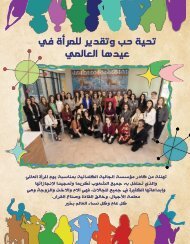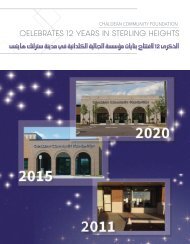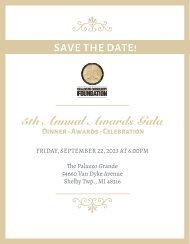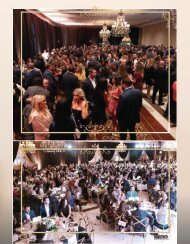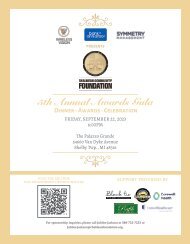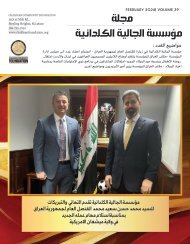FEBRUARY 2021
Create successful ePaper yourself
Turn your PDF publications into a flip-book with our unique Google optimized e-Paper software.
Clockwise from top<br />
left: 1. Wedding of<br />
Thomas Denha and<br />
Virginia Denha.Dr.<br />
Suad Yousif Mary as<br />
bridesmaid, Baghdad,<br />
1954. 2. Village<br />
wedding reception.<br />
3. Chaldean Wedding<br />
in Telkepe. Dikho<br />
Family - Courtesy of<br />
the Chaldean Heritage<br />
4.Chaldean Wedding -<br />
Zarna and Tabul.<br />
nial crowns represent Christ and the<br />
Church and the equality in their relationship<br />
– you need one to preserve<br />
the other.<br />
You will also see the Kalilla<br />
(white bow) tied to the groom’s arm<br />
at the reception. This bow signifies<br />
that the groom is taking leadership as<br />
the head of his family. The Church<br />
ceremony typically lasts for approximately<br />
one hour.<br />
Photography is a big part of the<br />
wedding occasion. A humorous incident<br />
occurred during one Chaldean<br />
wedding when the best man went<br />
missing. Messages were repeatedly<br />
announced by the band over loudspeakers<br />
requesting him to join the<br />
wedding party for photos. After several<br />
announcements, a gentleman<br />
stepped up and squeezed next to the<br />
groom, posing for the historic wedding<br />
party photo. The photographer,<br />
puzzled by the presence of this gentleman<br />
intruder, asked him, “Sir, why<br />
are you here?” The confident intruder<br />
replied, “You have been calling me<br />
all night, my name is “Basman!”<br />
It is both an American and a Chaldean<br />
tradition that the bride, groom<br />
and wedding party are introduced as<br />
they enter the reception celebration<br />
hall. The Arabic Zeffa is part of a tradition<br />
that makes it more fun and festive,<br />
and has evolved to include the<br />
cutting of the wedding cake.<br />
The characteristic Chaldean<br />
wedding reception usually commences<br />
rather late, around eight in<br />
the evening. To start the party, the<br />
entire bridal party is introduced<br />
during the Zeffa. Once guests have<br />
settled into their seats in the banquet<br />
hall, the bridesmaids and the<br />
groomsmen enter the venue as couples.<br />
Typically, each wedding party<br />
couple will dance their way into the<br />
banquet hall as guests cheer them on.<br />
The couples will continue cheering<br />
and dancing until the entire wedding<br />
party has entered the reception gathering.<br />
After all the wedding party has<br />
entered, everyone in attendance will<br />
head to the dance floor to celebrate<br />
the newlywed couple by dancing and<br />
singing for about a half hour or so before<br />
heading back to their tables.<br />
You’ll never go hungry when attending<br />
a wedding at a Chaldean<br />
banquet hall! To start, the tables are<br />
filled with an array of delicious appetizers.<br />
Wedding food is always plentiful<br />
for guests. Once the guests are fed,<br />
it’s time to hit the dance floor for the<br />
rest of the night.<br />
It’s imperative that all the guests<br />
help celebrate the newlywed couple<br />
by singing and dancing with them<br />
on the dance floor. While slower<br />
songs are sometimes played, the music<br />
tends to stay upbeat with a quick<br />
tempo so that the energy stays up.<br />
The bridesmaids and groomsmen<br />
play an important role in the reception.<br />
Part of their responsibility is<br />
to make sure that the dance floor<br />
is always full, and the party doesn’t<br />
stop. If the members of the wedding<br />
party are on the dance floor celebrating,<br />
it entices the guests to stay on<br />
the dance floor to celebrate as they<br />
dance to traditional Chaldean Khugga<br />
music.<br />
Usually around dinnertime, the<br />
newlywed couple will make their<br />
way around the banquet hall to greet<br />
their guests. Since most of the guests<br />
will be at their tables eating dinner,<br />
this is the ideal time for the bride and<br />
groom to say “hello” and thank them<br />
for being there.<br />
At this point in the celebration,<br />
everyone’s legs are most likely very<br />
tired from all the dancing, but there<br />
remains a buzz in the air from all the<br />
excitement and celebration.<br />
As every Chaldean knows, exiting<br />
out of a wedding celebration can<br />
take forever. Chaldeans are known<br />
for having very lengthy goodbyes.<br />
Once you decide it’s time to leave,<br />
it may take another twenty to thirty<br />
minutes before everyone has said<br />
their goodbyes and hugged each<br />
other; along the way, there’s always<br />
someone urging you to stay and keep<br />
partying. It’s a long process, but the<br />
love shown to each other makes it all<br />
worth it. By the night’s end, participants<br />
are completely exhausted.<br />
Weddings in general are extremely<br />
costly. Hosts spend a large amount<br />
of money on venues, food, and entertainment.<br />
To make their weddings<br />
extravagant, Chaldeans spend an<br />
obscene amount of money to impress<br />
their guests. During the wedding, instead<br />
of presenting gifts to the groom<br />
and bride, it is a tradition to gift<br />
money, because it is understood to<br />
be more useful than gifts, and to purchase<br />
what is needed. Gifting money<br />
is called “Sabahiyya.”<br />
As a guest at a Chaldean wedding,<br />
it will probably take a long<br />
time to recover from the excitement.<br />
This celebration is the most important<br />
day in the life of a couple, and<br />
you just witnessed a night they will<br />
remember for the rest of their lives.<br />
The one thing you feel during these<br />
weddings is the love radiating out<br />
from the bridal party to everyone. It<br />
is amazing how these traditions have<br />
remained intact, and goes to show<br />
how strong the Chaldean community<br />
is. We continue to encourage our<br />
sons and daughters to marry within<br />
the Chaldean community and to<br />
celebrate with the traditions of our<br />
culture.<br />
There’s no wedding like a Chaldean<br />
wedding.<br />
<strong>FEBRUARY</strong> <strong>2021</strong> CHALDEAN NEWS 21






